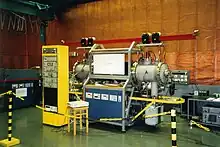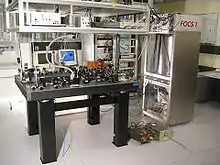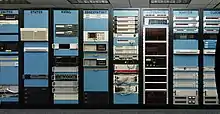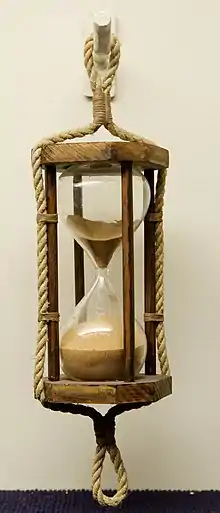List of atomic clocks
This is a list of some experimental laboratory atomic clocks worldwide.
| Name | Operation date | Type | Accuracy | Location | Image |
|---|---|---|---|---|---|
| CS1[1] | 1969 | Cs | 7×10−15 | ||
| CS2[2] | 1985 | Cs | 1.2×10−14 |  | |
| CS3 | 1988 | Cs | |||
| CS4 | 1992-2005 | Cs | .jpg.webp) | ||
| CSF1[3] | 1999 | Cs fountain | 4×10−16 | ||
| CSF2[4] | 2009 | Cs fountain | 2×10−16 | ||
| FOCS |  | ||||
| NPL-CsF2, Yb+ and Sr+ ion clocks, Sr lattice clock, 4 hydrogen masers[5][6] | |||||
| NIST-F1,[7] | Cs fountain | 3.1×10−16 |  | ||
| NIST-F2[9] | Cs fountain | 1.1×10−16 |  | ||
| USNO Alternate Master Clock |   | ||||
| WWV | |||||
| Department of Defense master clock |  | ||||
| 18 cesium atomic clocks and 4 hydrogen maser clocks | Cs, H | ||||
| Optical lattice clock | |||||
| NMIJ-F1, NMIJ-F2[16] | Cs fountain | 4.7×10−16 | |||
| Optical clock[17] | 2012 | Ca ion | |||
| Caesium Beam Atomic Clock[18][19] | Cs | ||||
| 9 Agilent 5071A caesium clocks[21] | Cs | 5×10−13 | |||
| KRISS-1[23][24] | Cs | 1×10−14 |  | ||
| Caesium atomic clocks[25] | Cs | ||||
| Five caesium clocks, one passive hydrogen maser, two active hydrogen masers.[26] | Cs, H | ||||
| DOST-PAGASA Juan Time[27] | |||||
| Caesium clocks, Hydrogen Maser [28] | Cs | ||||
| SOC: Space Optical Clock breadboard (Sr lattice clock)[29] | Sr lattice |
|
 | ||
| Deep Space Atomic Clock[30] | 2019-2021 | Hg ion | |||
| Caesium atomic clocks[31] | Cs |
References
- "Seit wann läuft die erste Atomuhr in der PTB?". Themenrundgänge / Fragen zur Zeit. Physikalisch-Technische Bundesanstalt. Archived from the original on 2012-11-27. Retrieved 2013-02-04.
- "Seit wann läuft die erste Atomuhr in der PTB?". Themenrundgänge / Fragen zur Zeit. Physikalisch-Technische Bundesanstalt. Archived from the original on 2012-11-27. Retrieved 2013-02-04.
- "Seit wann läuft die erste Atomuhr in der PTB?". Themenrundgänge / Fragen zur Zeit. Physikalisch-Technische Bundesanstalt. Archived from the original on 2012-11-27. Retrieved 2013-02-04.
- "Seit wann läuft die erste Atomuhr in der PTB?". Themenrundgänge / Fragen zur Zeit. Physikalisch-Technische Bundesanstalt. Archived from the original on 2012-11-27. Retrieved 2013-02-04.
- Palmer, Jason. "UK's atomic clock 'is world's most accurate'". BBC. Retrieved 2013-03-02.
- "Research - Time and Frequency". Retrieved 2015-06-12.
- "A Brief History of Atomic Clocks at NIST". The National Institute of Standards and Technology (NIST). Retrieved 2013-02-04.
- Newman, Michael E. (1999-12-29). "NIST-F1 Cesium Fountain Clock". NIST News. The National Institute of Standards and Technology (NIST). Retrieved 2013-02-04.
- "NIST Launches a New U.S. Time Standard: NIST-F2 Atomic Clock". The National Institute of Standards and Technology (NIST). Retrieved 2016-02-09.
- Newman, Michael E. (1999-12-29). "NIST-F1 Cesium Fountain Clock". NIST News. The National Institute of Standards and Technology (NIST). Retrieved 2013-02-04.
- "U.S. Naval Observatory Alternate Master Clock". U.S. Navy. Retrieved 2013-02-09.
- "Larimer County station helps set clocks". Fort Collins Coloradoan. Gannett Company. July 24, 2015. Retrieved August 27, 2018.
- "Mission of Japan Standard Time Group - Generation of Japan Standard Time (JST)". National Institute of Information and Communications Technology. Retrieved 2013-03-05.
- Motal, Julius (2011-08-30). "Japanese atomic clock is accurate to a 100 quadrillionth of a second". Geek.com. Ziff Davis, Inc. Archived from the original on 2012-06-14. Retrieved 2013-03-02.
- "Quantum Metrology Laboratory". RIKEN Advanced Science Institute. Archived from the original on 2013-03-03. Retrieved 2013-03-05.
- Takamizawa, A.; Yanagimachi, S.; Shirakawa, Y.; Watabe, K.; Hagimoto, K.; Ikegami, T., "Cesium Atomic Fountain Clocks at NMIJ" (PDF), Precise Time and Time Interval Systems and Applications Meeting, pp. 321–328, archived from the original (PDF) on 2011-04-28
- Wang, Yuanyuan (2012-07-12). "China unveils first optical clock". English News. Xinhuanet. Archived from the original on 2012-07-15. Retrieved 2013-02-04.
- "Caesium Beam Atomic Clock". The Government of the Hong Kong Special Administrative Region. Retrieved 2013-02-14.
- "History of Hong Kong Time Service". The Government of the Hong Kong Special Administrative Region. Retrieved 2013-02-11.
- "Contact us". The Government of the Hong Kong Special Administrative Region. Retrieved 2013-02-11.
- "Clocks and Time scales". National Time and Frequency Standard Laboratory. Retrieved 2013-02-14.
- "Current activities of the National Standard Time and Frequency Laboratory of the Telecommunication Laboratories" (PDF). Archived from the original (PDF) on 2013-02-17. Retrieved 2013-02-14.
- "Development of Korea's First Primary Frequency Standard, 'KRISS-1'" (PDF). KRISS. Retrieved 2013-03-01.
- Lee, Ho Seong; Kwon, Taeg Yong; Park, Sang Eon; Choi, Sang-Kyung; Park, Young-Ho (August 2004). "Research on Cesium Atomic Clocks at the Korea Research Institute of Standards and Science". Journal of the Korean Physical Society. 45 (2): 256–272. Archived from the original on 2016-03-04. Retrieved 2013-03-06.
- "About SST". National Metrology Centre. Archived from the original on 2013-04-18. Retrieved 2013-03-01.
- "Time and Frequency Metrology". CSIR-National Physical Laboratory. CSIR-National Physical Laboratory. Retrieved 2023-03-25.
- "With PST, "Filipino time" is now "on time"". Department of Science and Technology. Retrieved 2014-06-07.
- "Time Standard". Indonesian Institute of Sciences. Archived from the original on 2016-01-21. Retrieved 2016-06-22.
- "Space Optical Clock". Institut für Experimentalphysik, Heinrich-Heine-Universität Düsseldorf. Retrieved 2017-01-30.
- "Deep Space Atomic Clock". NASA's Jet Propulsion Laboratory. NASA. 27 April 2015. Retrieved 2015-10-28.
- "Uruchomiono najdokładniejszy zegar atomowy w Polsce. Nie straci nawet sekundy przez 200 mln lat". wyborcza.pl. Retrieved 2018-03-24.
This article is issued from Wikipedia. The text is licensed under Creative Commons - Attribution - Sharealike. Additional terms may apply for the media files.

.png.webp)